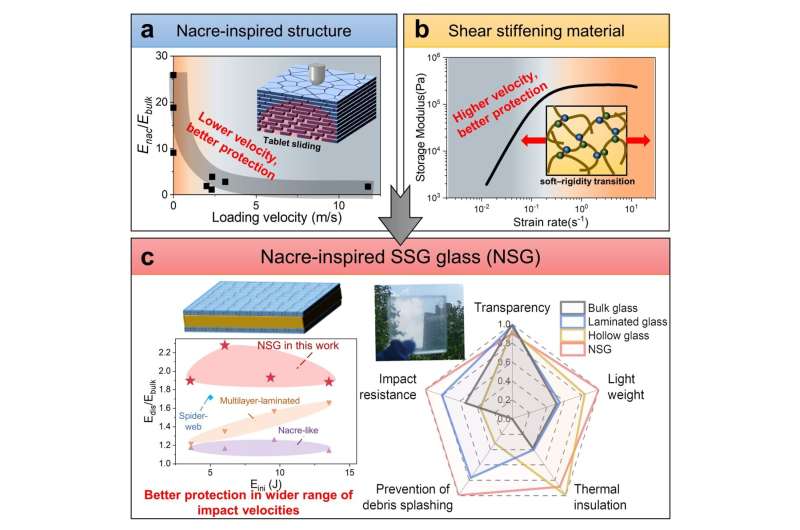This article has been reviewed according to Science X's editorial process and policies. Editors have highlighted the following attributes while ensuring the content's credibility:
fact-checked
proofread
Novel design enhances thermal insulation and impact resistance in composite glass

A research team led by Prof. Ni Yong and Prof. He Linghui from the University of Science and Technology of China (USTC) of the Chinese Academy of Sciences (CAS) has developed a new composite glass combining the nacre-inspired structure and shear stiffening gel (SSG) material, maintaining transparency while exhibiting excellent thermal insulation and impact resistance. Their work was published in Advanced Materials.
Bulk glass serves as an indispensable structural material in people's daily lives. However, glass has poor thermal insulation and is prone to fracture under impact, making it the weakest component in most buildings and transportation vehicles. There is an urgent need to develop new composite transparent materials with comprehensive performance.
To develop a novel composite glass, the team studied the nacre-inspired structure and the rheological properties of shear-stiffening materials. The natural nacre can dissipate energy through the tablet sliding mechanism under quasistatic or low-speed impact loading.
However, the impact resistance of the nacre-inspired structure diminishes rapidly with increasing impact velocities. In contrast, SSG exhibits strain-rate-dependent enhancement effects under impact loading, enabling them to dissipate a large amount of mechanical energy under high impact velocities.
To combine the advantages of nacre-inspired structures and shear-stiffening materials, the team constructed a biomimetic composite glass using SSG. The nacre-inspired SSG glass (NSG) was made up of two 1.4-mm-thick nacre-inspired glass face sheets and a 3.0-mm-thick SSG core.
The face sheets are composed of five borosilicate glass sheets and four polymeric interlayers in a 3D staggered brick-and-mortar arrangement, mimicking the structure of a natural nacre. After carefully aligning the two face sheets, the SSG core adhered to the face sheets facilitated by a coupling agent.
Mechanical simulation analysis revealed that the out-of-plane deformation of the nacre-inspired glass panels in NSG can further enhance the energy dissipation in the SSG core. The synergistic energy dissipation effect of the nacre-inspired structure and SSG enables the NSG to exhibit superior impact resistance across a broader range of impact velocities.
Furthermore, the NSG exhibits remarkable thermal insulation. The nacre-inspired glass panel, with its unique brick-and-mortar arrangement, effectively reduces surface heat conduction. Combined with the low thermal conductivity of the SSG core, the thermal insulation performance of NSG is significantly improved.
Compared to the commonly used bulk glass, NSG offers superior comprehensive performance in transparency, lightweight, impact resistance, and thermal insulation, paving a new way for the future improvement of transparent structural materials.
More information: Xiao Zhang et al, Simultaneous Enhancement of Thermal Insulation and Impact Resistance in Transparent Bulk Composites, Advanced Materials (2024). DOI: 10.1002/adma.202311817



















